New UN websites & publications
UN in General
General Assembly – Round-up Release 2023
English: https://press.un.org/en/2024/ga12579.doc.htm
French: https://press.un.org/fr/2024/ag12579.doc.htm
The Meetings Coverage Section of the Department of Global Communications has published its 2023 work summary of the main part of the seventy-eighth session of the General Assembly and its six Main Committees. Organized around themes, these summaries offer an overview of the issues discussed during the main part of the 2023 session of the General Assembly. It includes the general debate, held from 19 to 26 September 2023, with the participation of 136 Heads of State and Government. Aimed at delegations and the media, these summaries feature highlights of the debates, texts adopted, and emerging issues addressed by Member States.
Highlights of Security Council Practice 2023
https://www.un.org/securitycouncil/content/highlights-2023

Economic Growth and Sustainable Development
AA-HA! 2.0 – Web Version of the Accelerated Action for the Health of Adolescents (WHO)
https://www.who.int/initiatives/global-accelerated-action-for-the-health-of-adolescent/aa-ha!-guidance-2d-edition
WHO has developed this version – to enhance the accessibility of the AA-HA! content on a wide range of devices and operating systems, including computers, smartphones, and tablets, – to enhance users’ experience and engagement with the content by embedding seamless navigation across chapters and including hyperlinks to related external content and multimedia, – to ensure that users always have access to the latest WHO estimates on mortality and morbidity in adolescents that are presented in Chapter 2 of the guidance, and that new relevant resources are linked to the web AA-HA!2.0 in real time. However, this is an abbreviated version of the AA-HA!2.0 guidance. To have a full understanding of AA-HA! recommendations, please read the full document.
Dissecting the Decline in Average Hours Worked in Europe (IMF)
https://www.imf.org/en/Publications/WP/Issues/2024/01/10/Dissecting-the-Decline-in-Average-Hours-Worked-in-Europe-542417
Three years after the COVID-19 crisis, employment and total hours worked in Europe fully recovered, but average hours per worker did not. We analyze the decline in average hours worked across European countries and find that (i) it is not cyclical but predominantly structural, extending a long-term trend that predates COVID-19, (ii) it mainly reflects reduced hours within worker groups, not a compositional shift towards lower-hours jobs and workers, (iii) men—particularly those with young children—and youth drive this drop, (iv) declines in actual hours match declines in desired hours. Policy reforms could help involuntary parttimers and women with young children raise their actual hours towards desired levels, but the aggregate impact on average hours would be limited to 0.5 to 1.5 percent. Overall, there is scant evidence of slack at the intensive margin in European labor markets, and the trend fall in average hours worked seems unlikely to reverse.

https://unesdoc.unesco.org/ark:/48223/pf0000388010
As a first-of-its-kind global compilation featuring the history, typologies, compositions, and functions of city youth councils, the report seeks to underline promising practices of city youth councils informed by evidence-based methodology to determine their impact and effectiveness in inclusive urban governance. It proposes ideas to foster collaboration, amplify youth voices, and present recommendations to develop partnerships with Member States, local governments, youth associations, civil society, and other stakeholders to create inclusive communities. City youth councils offer a formalized arrangement for continuous dialogue with policymakers. They have played a key role in fostering the next generation of leaders and encouraging youth to be contributors and agents to social change and dialogue. Based on a survey among members of the International Coalition of Inclusive and Sustainable Cities, UNESCO is publishing this report to ensure that the actions and solutions proposed by youth can be applied and scaled up worldwide. It encourages local governments to create spaces for youth to participate actively and genuinely in decision-making processes.
Ethics and governance of artificial intelligence for health: Guidance on large multi-modal models (WHO)
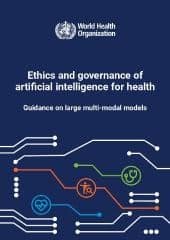
The World Health Organization (WHO) has released new guidance on the ethics and governance of large multi-modal models (LMMs) – a type of fast growing generative artificial intelligence (AI) technology with applications across health care. The guidance outlines over 40 recommendations for consideration by governments, technology companies, and health care providers to ensure the appropriate use of LMMs to promote and protect the health of populations. LMMs can accept one or more type of data inputs, such as text, videos, and images, and generate diverse outputs not limited to the type of data inputted. LMMs are unique in their mimicry of human communication and ability to carry out tasks they were not explicitly programmed to perform. LMMs have been adopted faster than any consumer application in history, with several platforms – such as ChatGPT, Bard and Bert – entering the public consciousness in 2023.
Expected socioeconomic impacts of the Gaza war on neighbouring countries in the Arab region (ESCWA / UNDP)
https://www.unescwa.org/publications/expected-socioeconomic-impacts-gaza-crisis-neighbouring-countries-arab-region
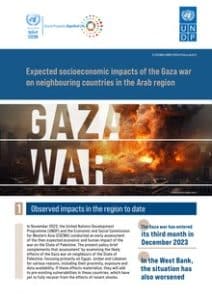
FAO launches new portal for statistics on Food and Diet
https://www.fao.org/faostat/en/#data/SUA
To help close data gaps and contribute to better guidance for nutrition-sensitive agrifood systems policies, the Food and Agriculture Organization of the United Nations (FAO) has created a new domain in the FAOSTAT portal. The domain presents harmonized food and nutrient statistics from different types and sources of dietary data. It reports statistics on the availability, apparent consumption, and dietary intake of foods, energy and 17 main nutrients thus capturing different dimensions across the food supply chain, from supply through to individual-level consumption. Statistics are available from 2010 for 186 countries in the section on food and nutrient availability, as they are based on the long-standing work done by FAO on food balance sheets – supply utilization accounts. Apparent food and nutrient intake is derived from data collected in household consumption and expenditure surveys that, so far, are available only in some of the countries. Information on food and nutrient intake is also presented coming from nationally representative individual intake surveys.
Global Employment Trends and the Water Dependency of Jobs (UNESCO)
https://unesdoc.unesco.org/ark:/48223/pf0000388410
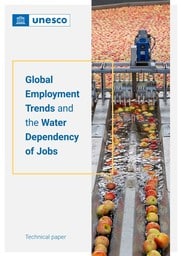
Migration and climate change in the Arab region (ESCWA)
https://www.unescwa.org/publications/migration-climate-change-arab-region
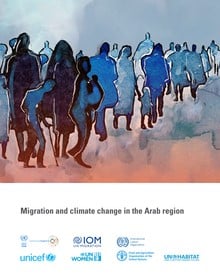
Preliminary Assessment of the Economic Impact of the Destruction in Gaza and Prospects for Economic Recovery: UNCTAD Rapid Assessment, January 2024
https://unctad.org/publication/preliminary-assessment-economic-impact-destruction-gaza-and-prospects-economic-recovery
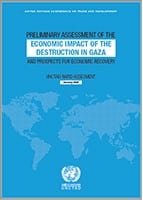
Preventing and addressing violence and harassment in the world of work through occupational safety and health measures (ILO)
https://www.ilo.org/global/publications/books/WCMS_908897/lang–en/index.htm

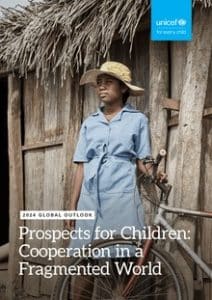
Prospects for Children in 2024: Cooperation in a Fragmented World – A Global Outlook (UNICEF)
https://www.unicef.org/globalinsight/reports/prospects-children-2024-global-outlook
Globally in 2024, children are likely to see increased exposure to violence and war, and economic hardship, says the UN children’s agency (UNICEF), in a flagship study released on 15 January 2024. At the beginning of each year, UNICEF looks ahead to the risks that children are likely to face, and suggests ways to reduce the potential harm. The latest report paints a picture of a short-term future characterized by continued conflict and economic uncertainty. Here is a breakdown of the main trends to look out for.
Realizing Decent Work in the Platform Economy (ILO)
https://www.ilo.org/ilc/ILCSessions/113/reports/reports-to-the-conference/WCMS_909906/lang–en/index.htm
This new Law and Practice report, published by the International Labour Organization (ILO), marks a crucial milestone in the process that can lead to a new international labour standard on decent work in the platform economy. It will be discussed at the 2025 and 2026 International Labour Conferences. The report provides up-to-date information on the way countries are handling the opportunities and challenges created by the growth of this form of work, by presenting a description of existing regulations and practices from around the world. The report also includes a questionnaire via which Governments are requested to provide their views on the form, scope, and content of any future labour standards.
User empowerment through Media and Information Literacy to the evolution of generative Artificial Intelligence (UNESCO)
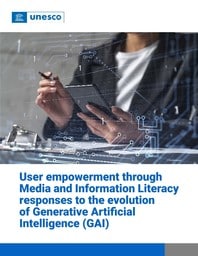
As the digital landscape is increasingly shaped by the widespread use of various GAI tools, this analysis aims to explore both the opportunities and risks associated with this innovative technology. The policy brief aims at examining and analyzing Media and Information responses to GAI development. Specific areas of examination include disinformation, hate speech, privacy and data rights infringement, source reliability and opportunities for lifelong learning. The policy brief complements UNESCO’s Guidelines for the Governance of Digital Platforms: safeguarding freedom of expression and access to information through a multistakeholder approach. Launched in 2023, the guidelines highlight MIL as a key element of the digital platform governance system.
World Employment and Social Outlook: Trends 2024 (ILO)
https://www.ilo.org/global/research/global-reports/weso/WCMS_908142/lang–en/index.htm
Labour markets have shown surprising resilience despite deteriorating economic conditions, but recovery from the pandemic remains uneven as new vulnerabilities and multiple crises are eroding prospects for greater social justice, according to a new International Labour Organization (ILO) report. The report finds that both the unemployment rate and the jobs gap rate – which is the number of persons without employment who are interested in finding a job – have fallen below pre-pandemic levels. The 2023 global unemployment rate stood at 5.1 per cent, a modest improvement from 2022 when it stood at 5.3 per cent. The global jobs gap and labour market participation rates also improved in 2023.
Coronavirus Disease (COVID-19)
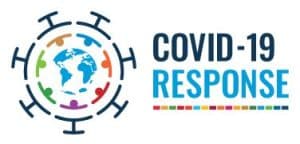
https://iris.who.int/bitstream/handle/10665/375831/WER9904-25-37.pdf
Understanding disinformation in the context of public health emergencies: the case of COVID-19
https://iris.who.int/bitstream/handle/10665/375832/WER9904-38-48.pdf
While digital tools have brought new opportunities to enhance health and well-being, they have also created new health security risks, such as cyber-attacks on health care and disinformation. To provide a clearer understanding of these risks and to reduce their likelihood and severity, WHO produced two reports, in collaboration with INTERPOL, the United Nations Office on Drugs and Crime (UNODC), the UN Office of Counter-terrorism, the UN International Computing Centre (UNICC), the UN Interregional Crime and Justice Research Institute, and the CyberPeace Institute. Published on 26 January 2024, the two reports identify ways to strengthen health security through operational solutions.
The first report, “Examining the threat of cyber-attack on health care during the COVID-19 pandemic”, highlights the far-reaching real-life impacts of cyber-attacks on health care. During the COVID-19 pandemic, health information technology (IT) infrastructure was increasingly targeted by cyber-attacks, at times hindering hospitals from delivering timely care when it was needed most. To restore IT systems and retrieve stolen data, health care facilities paid substantial ransoms. These attacks prompted law enforcement agencies to issue warnings about the threat of cyber-attacks to the health sector.
The second report, “Understanding disinformation in the context of public health emergencies: the case of COVID-19”, reflects on different approaches to counter disinformation. Disinformation, unlike misinformation, is created with malicious intent to sow discord, disharmony, and mistrust in targets such as government agencies, scientific experts, public health agencies, private sector, and law enforcement. In other words, disinformation is a weaponization of information.
International Peace and Security
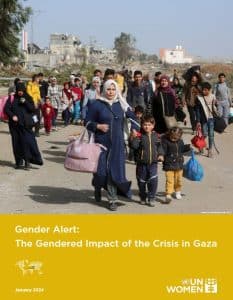
https://www.unwomen.org/en/digital-library/publications/2024/01/gender-alert-the-gendered-impact-of-the-crisis-in-gaza
Women and children account for roughly 70 per cent of people killed in the war in Gaza, with two mothers killed every hour since hostilities erupted more than 100 days ago, according to a UN Women report published on 19 January 2024. The report examines the gendered impact of the conflict, which has left more than 23,000 Palestinians dead, according to Gazan health authorities, about 16,000 of whom are women or children.
see also: Facts and figures: Women and girls during the war in Gaza (19 January 2024): https://www.unwomen.org/en/news-stories/feature-story/2023/10/facts-and-figures-women-and-girls-during-the-war-in-gaza
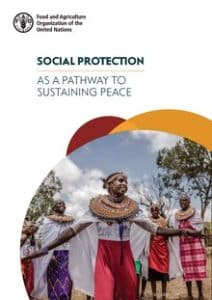
https://doi.org/10.4060/cc9175en
Global crises are becoming the new normal. From climate change to the contemporary food price crisis, vulnerable populations – and especially rural people – are facing increasingly difficult odds of flourishing. Such challenges are even more pronounced where there is conflict, whose multidimensional nature demands to direct more attention to its drivers and impacts. Over the past decades, social protection has contributed to development outcomes, such as those related to poverty reduction, food and nutrition security, and gender equality. Besides, social protection systems have proven to be effective also in addressing covariate shocks, as exemplified by the responses to the COVID-19 pandemic. There has instead been limited operational research regarding social protection’s contributions to peace. In order to start addressing this gap, this paper discusses how social protection can sustain peace efforts by understanding peace not as an outcome but, rather, as an ongoing process. The paper argues that the contributions that social protection can make to peace can be divided between two overlapping scenarios: “working in conflict” and “working on conflict”. While the former refers to efforts aimed at offsetting the impacts of conflict, the latter relates to interventions that intend to deliberately address its underlying drivers. The working paper also recognizes that social protection interventions in a conflict-affected context can potentially be harmful and fuel social tensions in the absence of adequate consideration of local power dynamics. It therefore calls for social protection strategies and programmes to be conflict-sensitive – beyond the “do no harm” – to make explicit contributions to peace.
Strengthening the Participation and Representation of Iraqi Women in Political and Electoral Processes
https://iraq.un.org/en/259090-strengthening-participation-and-representation-iraqi-women-political-and-electoral-processes
Key findings and recommendations from governorate-level consultations including local authorities, civil society organizations, former parliamentarians and Governorate Council members, youth, and women, conducted by the United Nations Assistance Mission for Iraq (UNAMI) and the National Directorate for Iraqi Women, General Secretariat of the Council of Ministers, Government of Iraq.
Human Rights

Advocacy Brief: End Immigration Detention of Children
https://www.unicef.org/documents/advocacy-brief-end-immigration-detention-children
This advocacy brief was developed by the United Nations Task Force on Children Deprived of Liberty, of which UNICEF is a member, and provides an overview of promising practices and lessons learned to end child immigration detention and sets out a range of policy actions needed to scale up efforts to end this form of violence.
Developing anti-FGM laws aligned with human rights (UNFPA / UNICEF)
https://www.unfpa.org/publications/technical-note-developing-anti-fgm-laws-aligned-human-rights


https://doi.org/10.54678/RYIW3623
The new toolkit empowers individuals and institutions to dismantle structures of racism, combat systemic discrimination, and work towards a more equitable and inclusive society. It underscores the need for comprehensive disaggregated data that reveals the true extent of racial inequalities and enables the development of informed policies based on evidence at the local, national and regional levels. It is a practical guide targeting policymakers, activists and organizations committed to anti-racism and anti-discrimination agenda. Drawing from global case examples and the latest research, it provides a step-by-step approach to developing, implementing, monitoring, and evaluating such policies.
Fisheries and the right to food in the context of climate change: Report of the Special Rapporteur on the right to food, Michael Fakhri (A/HRC/55/49, 9 January 2024)
English, French & Spanish: https://undocs.org/A/HRC/55/49
“Summary: In the present report, submitted to the Human Rights Council pursuant to Council resolution 43/11, the Special Rapporteur on the right to food, Michael Fakhri, provides a framework for the advancement of the rights of small-scale fishers, fish workers and Indigenous Peoples and a guide for States to ensure that the world’s aquatic ecosystems are biodiverse and safe and that States fulfil human rights obligations despite climate change challenges.”
ILO Factsheet on Forced Labour
https://www.ilo.org/brussels/publications/WCMS_908616/lang–en/index.htm
This note provides an overview of the ILO’s work to eradicate forced labour around the world. It highlights challenges at stake, key policy responses needed, as well as the ILO’s tools and ongoing initiatives in this area. The ILO’s work and expertise can significantly contribute to achieving the priorities set within the Neighbourhood, Development, and International Cooperation Instrument (NDICI)-Global Europe, particularly the priority areas 1.6 (people) and 3.1 (prosperity), which focus on promoting decent job creation based on the ILO’s fundamental labour standards.
Pathways to Better Protection: Taking stock of the situation of children in alternative care in Europe and Central Asia (UNICEF)
https://www.unicef.org/eca/reports/pathways-better-protection

Situation of Afghan women – Summary report of country-wide women’s consultations (December 2023)
https://unama.unmissions.org/sites/default/files/af-c509-q4-consultation-report-291123.pdf
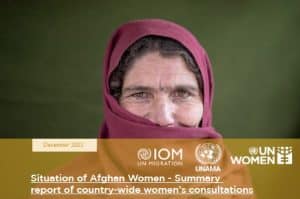
“We hope that our message will resonate with the world, and that we will not be left alone to fight for our rights.”
This brief presents the perspectives of women across Afghanistan on their current situation and priorities. It reflects the latest in a series of quarterly consultations with Afghan women documenting their experiences and policy recommendation since the Taliban takeover in August 2021.1 The de facto authorities (DFA) have enacted nearly 70 decrees and directives restricting women’s basic rights and fundamental freedoms,2 in effect, wholly excluding them from shaping their own futures and that of their country. Consultations with Afghan women help to understand their experiences, hopes and fears, and are aimed at amplifying their voices in national and international fora.
UN Women, the International Organization for Migration (IOM) and the United Nations Assistance Mission in Afghanistan (UNAMA) conducted in-person and online consultations and telesurveys reaching 462 women across 33 of 34 provinces.3 Women reflected on the preceding three months (August to October 2023), detailing their experiences, priorities and recommendations for the United Nations, UN Member States and other international actors to improve women’s rights in Afghanistan. This process consulted women heads of households; women who are internally displaced and from host communities; rural, peri-urban and urban women; employed and unemployed women; and women differing by age, marital status, ethnicity and educational background.
Humanitarian Affairs
Guidance Note: INFFs for Disaster Risk Reduction (DRR)
https://inff.org/assets/DESA_deep_dives/inff-and-drr.pdf
The United Nations Department of Economic and Social Affairs (UN DESA) and the United Nations Office for Disaster Risk Reduction (UNDRR) published on 29 January 2024 the “Integrated National Financing Frameworks (INFFs) for Disaster Risk Reduction (DRR)” Guidance Note. This technical guidance aims to address two of the biggest challenges countries face in protecting their development gains from disasters: how to fund risk reduction efforts and how to risk-inform investment decisions? Addressing these challenges is of relevance to all countries, but especially those that are most vulnerable to disasters, including Least Developed Countries and Small Island Developing States. The Guidance Note provides countries with a roadmap to fortify their resilience against disasters while ensuring sustainable development.

http://tinyurl.com/3wkbt3
The Libya Rapid Damage and Needs Assessment (RDNA) is an assessment report jointly developed by the World Bank (WB), the United Nations (UN), and the European Union (EU), in cooperation with other development partners, in the aftermath of the devastating storm and floods that affected eastern Libya between September 10 to 11, 2023. This report is an endeavor to stand by the Libyan people in this grave hour of need, and to support the efficient, sustainable, and resilient recovery of the disaster-affected region. The report constitutes an independent, impartial, and systematic assessment of the impacts of the disaster and the associated disaster recovery needs in the short to medium term.
Managing false information in health emergencies: an operational toolkit (WHO)
https://www.who.int/europe/publications/i/item/WHO-EURO-2024-8271-48043-71198
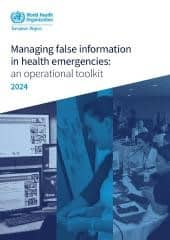
The toolkit outlines 5 key steps, offering a structured approach to managing false information in complex and intense situations such as emergencies. The first step is signal detection, which involves understanding the health narratives, questions, concerns, and information gaps of the audiences at risk. This can be done through online and offline methods, such as social media monitoring, focus groups and community engagement. The second step is signal verification, which requires fact-checking the information, analysing the source’s credibility, and comparing the information with other sources for accuracy and consistency. The third step is risk assessment, which evaluates the potential harm of the false information based on factors such as source credibility, spread, and public health impact. The fourth step is response design, which develops a communication plan to counter the false information and address the risks. The final step is outreach, which delivers the key messages to the targeted audiences, persuading them to adopt the desired health behaviours.
Two Years in Review: Changes in Afghan Economy, Households and Cross Cutting Sectors (UNDP)
https://www.undp.org/afghanistan/publications/two-years-review

Drug Control, Crime Prevention and Counter-terrorism
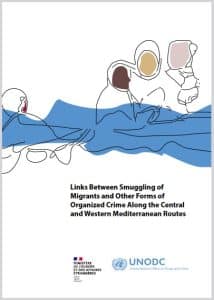
http://tinyurl.com/5xtntx5d
This UNODC report reveals that there is no single group dominating the migrant smuggling market on the two routes. Instead, a variety of actors with different levels of organization and coordination are active in the region. While some parts of the smuggling routes involve only individuals and small, loosely connected groups with little sophistication, others are under the control of powerful organized criminal networks with a high degree of hierarchy and professionalism, operating across several countries. The report stresses that migrant smuggling along these routes is linked to systemic corruption. Smugglers pay bribes on behalf of people on the move to state and non-state actors to facilitate the journey. This often involves illegal border crossings or forging fake passports and visas. Smuggling is often intertwined with drug trafficking, particularly of the synthetic opioid tramadol. Criminals are turning to this illicit business following a boom in demand across the Sahel, using the transport routes for migration. Recently, smuggling has emerged as a significant source of income for armed groups operating in the Sahel region. Their activities range from extorting passage fees from migrants to kidnapping and holding them in captivity for ransom.
